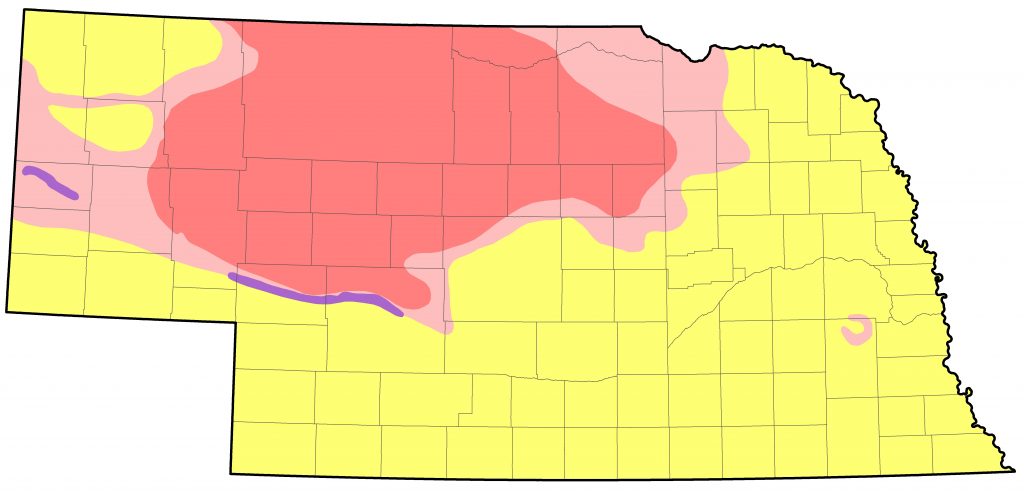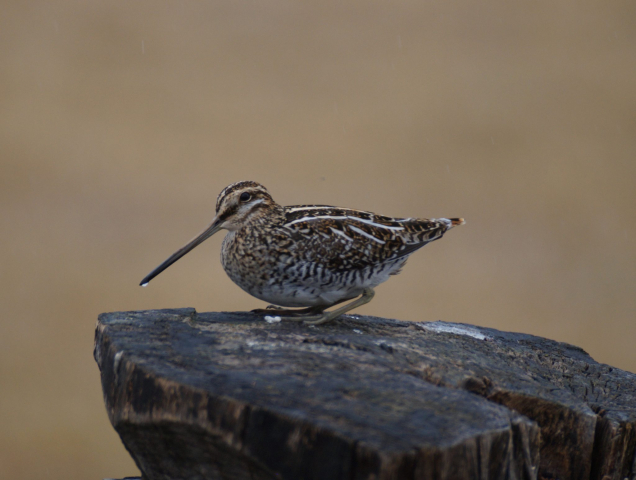Gallinago delicata
Status: Fairly common regular spring and fall migrant statewide. Uncommon regular breeder north and west, rare casual elsewhere. Uncommon regular local winter visitor North Platte River Valley, rare elsewhere.

Documentation: Specimen: UNSM ZM12634, 3 Nov 1910 Lancaster Co.
Taxonomy: This species was formerly treated as conspecific with Eurasian Common Snipe (G. gallinago), but the two were elevated to species status by Banks et al (2002).
No subspecies are recognized (AviList 2025).
Spring: Arrival and departure of spring migrants is difficult to discern due to wintering and summering birds. Reports increase during Mar-May however, presumably indicative of arriving migrants. Later reports in May and into Jun, especially if accompanied by territorial winnowing, may indicate breeding (see Summer). Wintering occurs widely (see Winter).
Migrants arrive by the end of Mar and peak migration occurs during early Apr.
- High counts: 130 in the eastern Rainwater Basin 3-4 Apr 1997 (including 38 at Bluewing WMA, Clay Co), 93 at Marsh Wren Community Wetlands, Lancaster Co 13 Apr 2019, 87 in the eastern Rainwater Basin 3 Apr 1999 (including 52 at Sinninger WPA, York Co), and 77 there 4 Apr 2004.
Summer: Despite presumptions that the species breeds regularly over much of northern Nebraska (Mollhoff 2016, Sharpe et al 2001), the species’ breeding status is poorly defined. There are areas, such as the Sandhills, where the species occurs regularly during summer and presumably breeds, but documented records are few (Ducey 1988, Mollhoff 2016). In other portions of the state, especially east and south of the Sandhills, there are occasional reports of winnowing birds, a territorial behavior indicative of breeding.
Breeding apparently occurs regularly north of the Platte and North Platte rivers in the Sandhills and Panhandle, east to Holt, Knox, Antelope, and Pierce Cos. However, in large portions of this area, breeding birds may be rare or absent. For example, Rosche (1982) considered Wilson’s Snipe a “locally rare summer visitant” in his study area that included Box Butte, Dawes, Sheridan and Sioux Counties. Rosche (1982) noted territorial birds occurred regularly in the Smith Lake region of Sheridan County but also that “we have no evidence of nesting at this time”.
Breeding possibly occurs with some regularity in the eastern saline wetlands of Lancaster and southern Saunders Cos where winnowing birds are occasionally observed. Nests with eggs were at Jack Sinn WMA, Lancaster Co 28 Apr 1984 (J. Dinan; Mollhoff 2022) and 6 May 1986 (Lesiak; Mollhoff 2022), but there are no recent records other than a single bird at Wagon Train Lake SRA, Lancaster Co 20 Jun 2018. Singles were at Lake Wanahoo, Saunders Co 20 May 2020 and Tamora WPA, Seward Co 26 May 2020.
Mollhoff (2016) suggested breeding may occur at scattered sites in the Rainwater Basin, but Jorgensen (2012) listed only two reports during late May through June; recent reports are of singles at Father Hupp WMA, Thayer Co 12 Jun 2021, Ayr Lake, Adams Co 19 Jun 2019, Hultine WPA, Clay Co 2 Jul 2019, Troester WPA, Hamilton Co 8 Jul 2021, and Kirkpatrick South WMA, York Co 9-21 Jul 2022.
- Breeding Phenology:
- Courtship (winnowing): 11 Apr-16 Jul, 27 Aug
Eggs: 28 Apr – 24 Jun (Mollhoff 2022)
Young: 10 May – 12 June
Laying is preceded by up to two weeks of territorial winnowing by males (Johnsgard 1979, Mollhoff 2008). Winnowing was recorded in York Co 16 Jul 2022, and 27 Aug, rather late; such birds may be unmated males (Mueller 2020).
Fall: Arrival and departure of fall migrants is difficult to discern due to summering and wintering birds. There is an increasing frequency of reports Aug-Oct however, presumably including migrants. Later reports in Oct and later may indicate wintering birds (see Winter).
Apparent migrants become evident in non-breeding locations by late Jul; these are probably failed breeders, which leave breeding areas in mid-Jul (O’Brien et al 2006), although successful breeders from the nearby Sandhills might also account for these late Jul reports. Such reports are of one in Sarpy Co at a sod farm 26 Jul 2005, eight in the eastern Rainwater Basin 28 Jul 2001, three in Lancaster Co 30 Jul 2009, two at Jack Sinn WMA, Lancaster Co 30 Jul 2016, and singles in York Co 29 and 31 Jul 2003.
Peak numbers occur during each of Sep and Nov; the early peak is probably of females, and the later peak males; juveniles of each sex move earlier than adults (Mueller 2020).
- High counts: 200+ at Harvard WPA, Clay Co 6 Nov 2005 (Jorgensen 2012), 156 at Highway 26 Playa, Scotts Bluff Co 29 Sep 2022, 145 there 10 Nov 2023, 125 on 90th Rd, Hall Co 15 Sep 2019, 115 at Highway 26 Playa 26 Sep 2023, and 109 in Burt Co 25 Oct 2018.
Winter: This species winters locally, especially in areas with warm water springs that provide soft mud for probing. There are multiple Jan-Feb reports from Scotts Bluff, Keith, Lincoln, and Lancaster Cos, but Feb reports are restricted to sites in the North Platte River Valley, notably in the North Platte area.
It has been reported in midwinter as far north as Dawes, Cherry, and Antelope Cos. Rosche (1982) listed “Common” Snipe as an uncommon winter visitant in northwest Nebraska.
There are numerous reports in Jan, with fewest reports in Feb; away from the North Platte River Valley, the only Feb report is 22 Feb 2018 Lancaster Co.
- High Counts: 25+ Hiatt Memorial Wetland, North Platte 8 Jan 2014.
Images
Abbreviations
SRA: State Recreation Area
UNSM: University of Nebraska State Museum
WMA: Wildlife Management Area (State)
WPA: Waterfowl Production Area (Federal)
Literature Cited
AviList Core Team, 2025. AviList: The Global Avian Checklist, v2025. https://doi.org/10.2173/avilist.v2025.
Banks, R.C., C. Cicero, J.L. Dunn, A.W. Kratter, P.C. Rasmussen, J.V. Remsen, Jr., J.A. Rising, and D.F. Stotz. 2002. Forty-third supplement to the American Ornithologists’ Union check-list of North American birds. Auk 119: 897-906.
Ducey, J.E. 1988. Nebraska birds, breeding status and distribution. Simmons-Boardman Books, Omaha, Nebraska, USA.
Johnsgard, P.A. 1979. Birds of the Great Plains: breeding species and their distribution. University of Nebraska Press, Lincoln, Nebraska, USA.
Jorgensen, J.G. 2012. Birds of the Rainwater Basin, Nebraska. Nebraska Game and Parks Commission, Lincoln, Nebraska, USA.
Mollhoff, W.J. 2008. The 2007 Nebraska nest report. NBR 76: 155-165.
Mollhoff, W.J. 2016. The Second Nebraska Breeding Bird Atlas. Bull. Univ. Nebraska State Museum Vol 29. University of Nebraska State Museum, Lincoln, Nebraska, USA.
Mollhoff, W.J. 2022. Nest records of Nebraska birds. Nebraska Ornithologists’ Union Occasional Paper Number 9.
Mueller, H. 2020. Wilson’s Snipe (Gallinago delicata), version 1.0. In Birds of the World (A. F. Poole and F. B. Gill, Editors). Cornell Lab of Ornithology, Ithaca, NY, USA. https://doi.org/10.2173/bow.wilsni1.01.
O’Brien, M., R. Crossley, and K. Karlson. 2006. The Shorebird Guide. Houghton Mifflin Co., New York, New York, USA.
Rosche, R.C. 1982. Birds of northwestern Nebraska and southwestern South Dakota, an annotated checklist. Cottonwood Press, Crawford, Nebraska, USA.
Sharpe, R.S., W.R. Silcock, and J.G. Jorgensen. 2001. The Birds of Nebraska: their Distribution and Temporal Occurrence. University of Nebraska Press, Lincoln, Nebraska, USA.
Recommended Citation
Silcock, W.R., and J.G. Jorgensen. 2025. Wilson’s Snipe (Gallinago delicata). In Birds of Nebraska — Online. www.BirdsofNebraska.org
Birds of Nebraska – Online
Updated 11 Jul 2025

